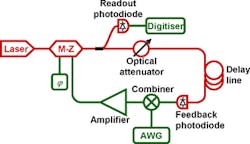Photonic reservoir computing—a new tool for speech recognition

As you read in my Photon Focus blog of August 5, 2014 entitled "Photonics gets personal: Lasers and SCI", much of my mental energy is focused these days on my husband's recovery from his spinal cord injury (SCI) back in May. And unfortunately, much of my energy is spent on being frustrated at the lack of medical tools and even simple instrumentation for bed-ridden patients. Case in point: The lack of nurse call button methods for paralyzed patients.
It is scary to think that a paralyzed patient cannot call the nurse if they are in trouble (no ability to push the call button; see image below from www.curbell.com). I have been to four hospitals and trauma units and NONE of them have a call-button system that works on paralyzed patients who are unable to speak (maybe this technology will someday work: http://www.telegraph.co.uk/science/science-news/7987821/Mind-reading-machine-can-convert-thoughts-into-speech.html). If my photonic (or electronic)-oriented friends could come up with a low-cost system, they could surely sell it worldwide. But what really infuriates me is that even at my husband's current neurorehabilitation facility—one of the best in the United States—there is no voice-activated call-button technology available now that he's regained his speaking voice. Yes he can yell from his room, but a weak voice cannot be heard as the nurse's station is often empty and the halls are long and lonely—especially nights and weekends.The director of nursing claims that they have evaluated several voice-activated call systems, but that they are not reliable, require customization for each patient's speaking voice, and are expensive. My response: sheer exasperation. So just for fun I started looking around the internet and indeed, there are some articles/references to voice-activated call systems (see http://www.ele.uri.edu/courses/bme281/F00/Rachel_George_CallBell.pdf), but commercial product availability does appear limited (see one system described at http://prezi.com/ekv1oluwe2ck/hands-free-call-bell-system/). And so to make a long-story short, I started looking at voice-recognition technology—which I assumed to be all-electronic—when I came across information on "photonic reservoir computing" for improving speech recognition (which is the translation of spoken words into text according to Wikipedia (http://en.wikipedia.org/wiki/Speech_recognition).
So what is photonic reservoir computing? After browsing through several abstracts and papers, I'm still not entirely sure. Perhaps the following abstract (from http://link.springer.com/chapter/10.1007%2F978-3-540-85673-3_4#page-1 and researchers at Ben-Gurion and Stuttgart University) can explain it:
"We propose photonic reservoir computing as a new approach to optical signal processing and it can be used to handle for example large scale pattern recognition. Reservoir computing is a new learning method from the field of machine learning. This has already led to impressive results in software but integrated photonics with its large bandwidth and fast nonlinear effects would be a high-performance hardware platform. Therefore we developed a simulation model which employs a network of coupled Semiconductor Optical Amplifiers (SOA) as a reservoir. We show that this kind of photonic reservoir performs even better than classical reservoirs on a benchmark classification task."
Here are some resources:
http://www.ukessays.com/essays/computer-science/photonic-reservoir-computing-as-a-new-method-computer-science-essay.php
http://www.nature.com/srep/2012/120227/srep00287/full/srep00287.html
http://proceedings.spiedigitallibrary.org/proceeding.aspx?articleid=939394
http://ieeexplore.ieee.org/xpl/login.jsp?reload=true&tp=&arnumber=5548990&url=http%3A%2F%2Fieeexplore.ieee.org%2Fxpls%2Fabs_all.jsp%3Farnumber%3D5548990
Apparently, using SOA technology, photonic reservoir computing combines classic neural networks with a photonic readout system, and according to the resource papers above, improves over classical reservoir systems (see the figure below of an experimental setup from the Nature link above).And now, as I've reached the limit of my understanding of this subject (and this blog is getting way too long), I challenge our Laser Focus World audience to let us know if you are familiar with this technology and what practical applications it may be addressing (it would make a great news story for the magazine). Feel free to email me at [email protected].
About the Author

Gail Overton
Senior Editor (2004-2020)
Gail has more than 30 years of engineering, marketing, product management, and editorial experience in the photonics and optical communications industry. Before joining the staff at Laser Focus World in 2004, she held many product management and product marketing roles in the fiber-optics industry, most notably at Hughes (El Segundo, CA), GTE Labs (Waltham, MA), Corning (Corning, NY), Photon Kinetics (Beaverton, OR), and Newport Corporation (Irvine, CA). During her marketing career, Gail published articles in WDM Solutions and Sensors magazine and traveled internationally to conduct product and sales training. Gail received her BS degree in physics, with an emphasis in optics, from San Diego State University in San Diego, CA in May 1986.

